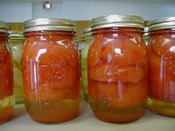Canning season is almost here. Now is the perfect time to inspect, and if necessary, replace worn out equipment and obtain new recipes from reliable, tested resources.
Resources available include the University of Georgia Cooperative Extension’s So Easy to Preserve (5th edition) and the The Ball Blue Book - Guide to Home Canning, Freezing and Dehydration.
There are also local canning classes are available. The next CCEFM Master Food Preserver class is set for July 19 in Johnstown.
Whether you’re new to canning or an old hand, a little planning can make your experience a little easier. You can get the most out of your canning by following these simple guidelines:
>Instead of canning alone, share the rewards by having a friend or your children pitch in.
> Be efficient. Plan ahead and group fruits, vegetables and meats according to the way they’re canned and types of equipment used. Schedule jams, fruit butters and conserves in one group and pickled vegetables and relishes in another.
> Don’t go overboard trying to do everything at once. Estimate carefully (and honestly) how much time you’ll need to prepare, process and cool the products.
> Begin canning early in the day when you’re fresh, and the kitchen is cool.
> Set out all the equipment the day before. Check your jars for nicks. Make sure screwbands are not rusted or bent and that you have enough new lids for your canning needs.
By carefully planning out your day, you’ll make canning simple, efficient and rewarding.
Resource: Cindy Shuster, Associate Professor, Extension Educator, Family & Consumer Sciences, Perry County, Ohio State University; revised by Judy Price and Katherine Humphrey, NYS Food Preservation Experts, Cornell Cooperative Extension, 5/2009.







